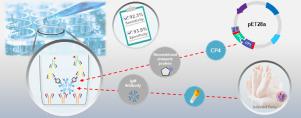Acta Tropica ( IF 2.1 ) Pub Date : 2020-11-04 , DOI: 10.1016/j.actatropica.2020.105738 Luz María Peverengo , Luz María Rodeles , Camila Maldonado , Griselda Ballering , Nazarena Pujato , Indira D’Amico , Miguel Hernán Vicco , Luciana Garcia , Laura Jurado , Jaime Altcheh , Iván Marcipar

|
Transplacental transmission by Trypanosoma cruzi (T. cruzi) infection can be effectively treated if parasiticide drugs are administered as early as possible during childhood. Furthermore, an ideal situation would be to diagnose the infection near birth in order to avoid the loss of patients during the subsequent follow-up. These situation are desirable due to the maximum benefit of drugs in early stages which, consequently, implies a relevant contribution to eliminate mother-to-child transmission. However, available techniques for that purpose have limitations as being operator-dependent (microhematocrit), require several months follow-up (IgG detection) or specialized laboratories (PCR). In this study we propose to detect specific IgM antibodies (Ab) by developing a capture-based ELISA employing an improved antigen (Ag) to diagnose the transplacental transmission of T. cruzi, and in consequence, to enhance access to effective treatment. Firstly, a new chimera Ag (CP4) was obtained from the fusion of CP1 and CP3 protein, carrying FRA, SAPA, MAP, TSSAII/V/VI and TcD Ag from T. cruzi. Then, we optimized the assay by capturing IgM Ab with a polyclonal anti-IgM Ab and evaluating three Ag formulations to detect specific IgM bound. The formulations were formed as follows: i) F1: CP1 and CP3; ii) F2: CP1, CP3, B13 and P2β; iii) F3: by CP4. Detection of Ab-binding Ag was carried out using an anti-His Ab since all Ag were expressed with a His-tag. The evaluation panel consisted of sera from vertically infected children under 1-year-old (6 younger than 15 days, 7 older) and samples from non-infected children of women with chronic Chagas Disease. The ELISA assay employing CP4 showed better performance with notable high sensitivity and specificity (92.3% and 93.9%, respectively). Positive and negative likelihood ratios of the test (15.2 and 0.082) suggest its potential clinical relevance in term of post-test probability of infection. In conclution, we developed a standardized and non-operator dependent test to detect specific anti-T. cruzi IgM Ab. Although increased sample size is needed for its validation, our results indicate that this capture-based technique employing CP4 Ag can certainly improve the diagnosis of connatal infection.
中文翻译:

先天性南美锥虫病:基于IgM捕获的特异性检测方法的开发和评估
由克氏锥虫胎盘传输(克氏锥虫)如果在儿童期尽早施用杀寄生虫药,则可以有效治疗感染。此外,理想的情况是在临产时诊断感染,以避免在随后的随访中失去患者。由于药物在早期阶段具有最大的益处,因此这些情况是可取的,因此,这意味着在消除母婴传播方面做出了重要贡献。但是,用于该目的的可用技术存在局限性,因为它依赖于操作员(微血细胞比容),需要几个月的随访(IgG检测)或专门实验室(PCR)。在这项研究中,我们建议通过开发基于捕获的ELISA方法来检测特异性IgM抗体(Ab),该方法采用改良的抗原(Ag)来诊断T. cruzi的胎盘传播,从而增加获得有效治疗的机会。首先,从CP1和CP3蛋白的融合物中获得了一种新的嵌合Ag(CP4),其携带了来自克鲁氏T的FRA,SAPA,MAP,TSSAII / V / VI和TcD Ag 。。然后,我们通过用多克隆抗IgM Ab捕获IgM Ab并评估三种Ag制剂来检测特异性IgM结合来优化测定。配方形成如下:i)F1:CP1和CP3;ii)F2:CP1,CP3,B13和P2β;iii)F3:通过CP4。由于所有Ag均带有His标签,因此使用抗His Ab进行Ab结合Ag的检测。评估小组包括来自1岁以下垂直感染儿童(15天以下6岁,7岁以上)的垂直感染儿童的血清,以及患有慢性恰加斯病的女性未感染儿童的样本。采用CP4的ELISA分析显示出更好的性能,并具有显着的高灵敏度和特异性(分别为92.3%和93.9%)。测试的阳性和阴性似然比(15.2和0.082)表明了其在测试后感染可能性方面的潜在临床意义。T.克鲁兹IgM Ab。尽管需要增加样本量来进行验证,但我们的结果表明,这种采用CP4 Ag的基于捕获的技术肯定可以改善对产后感染的诊断。











































 京公网安备 11010802027423号
京公网安备 11010802027423号